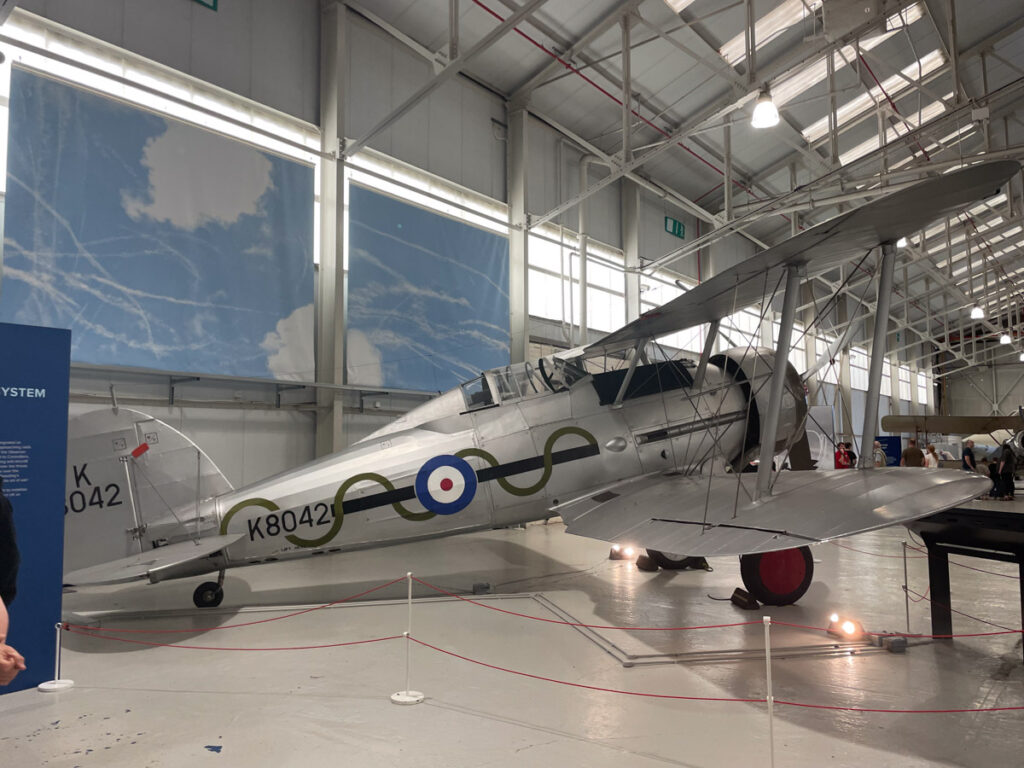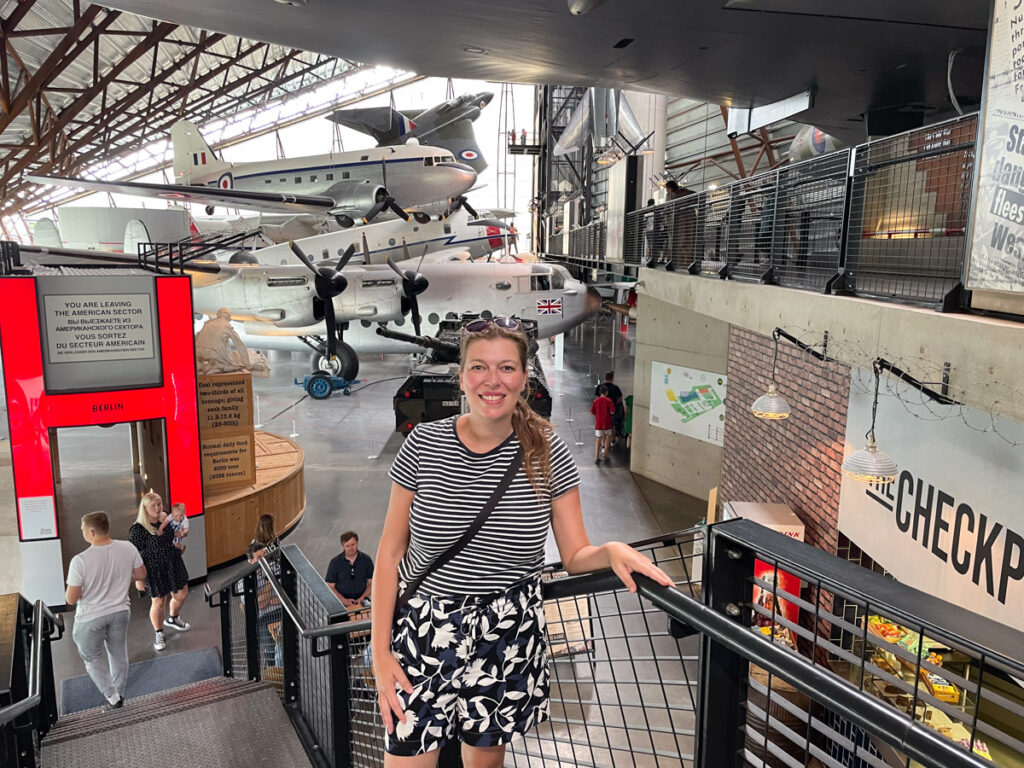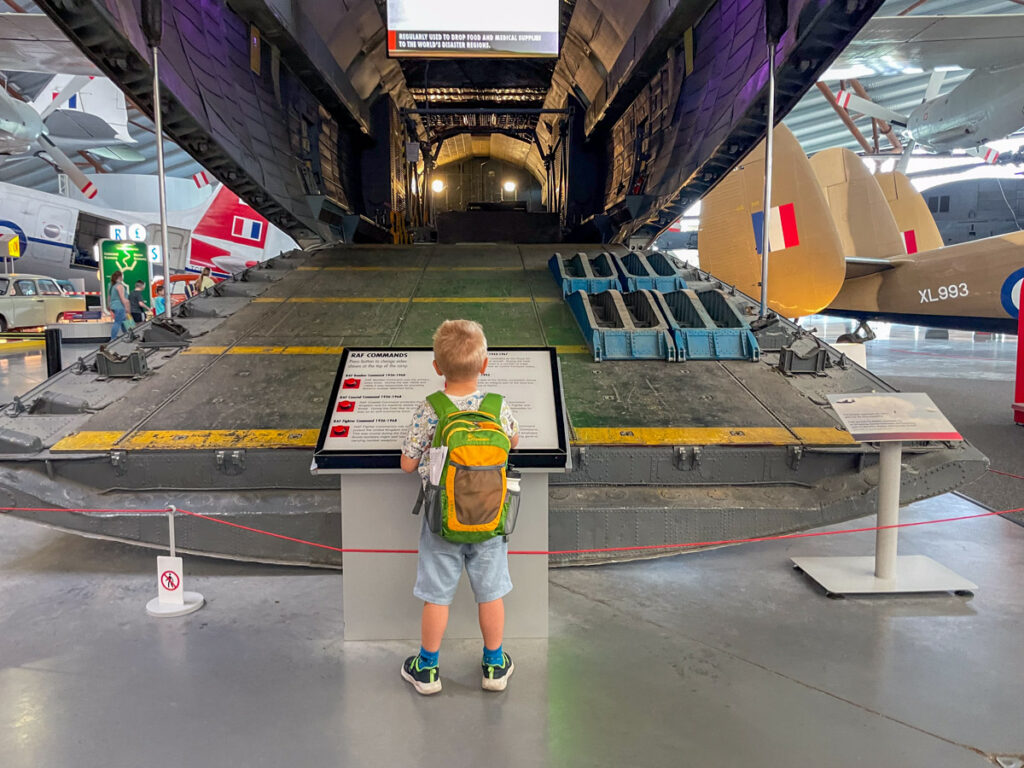As my son and I share a passion for aviation, we were thrilled to discover the Royal Air Force Museum Midlands, one of the best aviation museums we visited in the UK. Located in Cosford, close to Birmingham, this museum is a must-visit for anyone interested in the history of the RAF and the aircraft that have played a crucial role in its success. We visited with friends, and it’s perfect for a family-friendly day out thanks to the free admission, the exhibits suitable for everyone, his fantastic aviation-themed playground, the lovely restaurant and picnic areas.
Table of Contents
Women Pilots of RAF Cosford: A Fascinating Piece of Aviation History
RAF Cosford is the location of the Royal Air Force Museum Midlands and is also home to the RAF’s only official Air Show. It was established in 1938 as a Technical Training School, initially intended for Aircraft Storage Unit. During World War II, RAF Cosford housed the 12 Ferry Pilots’ Pool and an Air Transport Auxiliary unit responsible for delivering new and repaired aircraft to operational units.
PLAN YOUR TRIP TO ENGLAND
Stay connected in England with a giffgaff free SIM or an Airalo eSim for seamless data coverage throughout the UK. Additionally, rent a car in the United Kingdom to explore all the attractions of the British countryside, including the fantastic museums on my blog!
From 1943 to 1945, the Pool was exclusively staffed by women, with Marion Wilberforce commanding the unit. She obtained her pilot’s license in 1930 and was qualified to fly over 100 aircraft types, including Lancasters and Mosquitos! Furthermore, she flew privately until her 80th birthday, inspiring many women to become pilots. Following the war, RAF Cosford resumed its original training function.
What’s On at the Royal Air Force Museum Midlands
Royal Air Force Museum Midlands is one of the UK’s National Museums. Its hangars house the world’s oldest Spitfire and other classic war aircraft. The museum also has an RAF-themed playground outside, making it perfect for a family visit.
The museum boasts a vast collection of aircraft and aviation-related objects, ranging from early flight pioneers to modern military planes. As I walked through the exhibits, I was impressed by the meticulous attention to detail and available information.
The museum’s highlights included World War II-era planes, Cold War exhibits, and the stories of those who worked and flew at RAF Cosford. Everything is incredibly well-documented, offering a genuine glimpse into when the Royal Air Force base was operational.

Hangars 1: Transport and Training
Hangar 1 exhibits a wide range of Royal Air Force aircraft for transport and training. You can see how transport and communications aircraft are crucial for air forces to move troops and equipment. The collection includes some of the largest machines flown by the RAF, such as the Chinook’ Bravo November’ helicopter, which played a vital role in British military operations during the Falklands campaign in 1982.
You can also see some training aircraft within Hangar 1. These planes are often basic, designed to teach aspiring pilots the fundamental aspects of flying before they move on to more advanced aircraft. This approach is still followed in modern flying schools today!
Hangar 2: RAF History and Test Flight
Hangar 2 showcases the history of the Royal Air Force. It starts with a display of three early First World War aircraft, followed by two Hawker aircraft representing the RAF in the interwar period. The Royal Air Force is the first line of the UK’s defence, and in Hangar 2, you can learn about its mission and accomplishments over the past 100 years.
In this museum, you can also discover the Red Arrows, the aerobatic team of the Royal Air Force, and witness the evolution of aircraft technology from fixed-wing aircraft to jet flap technology, which reduces take-off and landing distances, with the world air speed record-smashing FD2, the prototype Eurofighter EAP, and the iconic TSR-2.
Hangar 3: Air Combat
Hangar 3 is the home of the Vickers Wellington, the most produced British bomber during World War II. The hangar also houses a collection of British and German aircraft from the Battle of Britain era, as well as Japanese aircraft. Here, you can see the Spitfire, Hurricane, Defiant, and their rival, the Messerschmitt Bf 109E.
In Hangar 3, you can also find some of the mascots and lucky charms of pilots who flew for the RAF during the wars. Since RAF aircraft did not have personal marks or artworks like those seen on US aircraft, pilots often carried lucky charms such as a rabbit’s foot, a black cat or a medal of St Christopher, the Saint Patron of travellers. One of the most popular mascots was Twinkletoes, the lucky black cat who belonged to navigator Flight Lieutenant Arthur Brown during the historic first transatlantic flight in 1919. Today, you can buy a cute replica in the museum shop.

Hangar 4: The National Cold War Exhibition
The National Cold War Exhibition at the Royal Air Force Museum Midlands is one of the most fascinating exhibits I have ever seen. After the Second World War ended, Winston Churchill famously observed that an ‘Iron Curtain’ had descended upon the continent of Europe. For 40 years, the East and West stood on either side of an ideological divide.
The exhibit explores the aftermath of the alliance between Britain and the United States against the Soviet Union at the end of the Second World War, until the end of the Cold War, when the Soviet Union collapsed in 1991. The National Cold War Exhibition highlights both sides’ ideologies and the technological achievements that arose from the competition between East and West.
It was really interesting to see how the relationship between the Western Allies and the Soviet Bloc was often tense, with a constant threat of nuclear war but without direct military confrontation. The exhibition aims to inform and educate present and future generations about the significant threat to world peace and security during the 20th century. If you’re a history buff like me, I highly recommend checking it out.

Interactive Activities at the Royal Air Force Museum Midlands
At the Royal Air Force Museum Midlands, you can participate in interactive activities or tours that can be booked online or at the Visitor Centre. The tours allow you to explore the history of the RAF and its unique stories, from the earliest days of flight to iconic aircraft such as Spitfires and the Vulcan. Many tours, such as the National Cold War Exhibition, the Bomber Command, and the Battle of Britain, are available. Tours are recommended for a minimum age of 12, with pre-booking required, and they cost £10 per person.
In the Flight Zone of the museum, you can find VR, simulators, and 4D theatre shows that are perfect for families. The latest haptic and virtual reality technology allows visitors to experience key events from the Dambusters Raid in 1943 aboard a Lancaster plane. You can also sit in a replica of a Second World War Spitfire cockpit, try the RAF Eurofighter Typhoon simulator to fly over the Lake District or become a Spitfire pilot in the Virtual Reality Zone.
Another immersive experience is the paragliding experience, where you can explore the desert, mountains, and even outer space while flying through virtual rings on a mission to collect points. The 4D Theatre combines thrilling motion pictures with synchronized seat movements, water spray, and smoke effects.
Although the interactive experiences are fascinating, we didn’t have time to try them as the exhibits at the Royal Air Force Museum Midlands were so interesting that our eyes were only for planes. Prices for the interactive experiences start from £4.50 for the simulator experience. I would have liked to try one of the tours, but unfortunately, my son and his friend were too young at our visit.
Royal Air Force Museum Midlands with Kids
The Royal Air Force Museum Midlands is really family-friendly. The museum provides a variety of activities and experiences perfect for children. These include interactive exhibits, hands-on displays, and outdoor play areas designed to engage and involve young kids.
The aviation-themed playground is particularly impressive. Children who dream of becoming pilots will love it. The playground features an aircraft that kids can climb aboard, as well as a slide and climbing frame. The playground’s design is inspired by the real aircraft on display within the museum.
The outdoor playground is conveniently located next to the Visitor Centre, with outdoor seating areas available. After lunch at the Airfield Kitchen, you can relax with a cup of coffee while your children play. Then, you can continue their visit to the museum, as we did.

Useful Information to Visit the Royal Air Force Museum Midlands
The website of the Royal Air Force Museum Midlands recommends spending four hours for a full visit, but we spent almost the whole day there and could’ve easily spent more time! The exhibits were so interesting that we wanted to come back and learn more about what we liked the most.
If you want to book any activities or ask for information, you can go to the Visitor Centre, which is the welcome point at the start of your visit. The staff at the Admissions Desk are available to answer any questions you may have. You can also purchase a souvenir guidebook for your visit at £5.00. I usually collect guidebooks of museums I visit in the UK, and this one is even more interesting as it explains the exhibits in detail. It’s a perfect souvenir to take home!
Where to eat at the Royal Air Force Museum Midlands
There are several options for eating or having a coffee at the Royal Air Force Museum Midlands. For a proper lunch, you can visit the Airfield Kitchen located at the entrance in the Visitor Centre. They offer a convenient lunch menu, coffee, and snacks at reasonable prices. However, it can get quite crowded during breakfast and lunch time.
In case you prefer to bring your own food, there are picnic areas available outside. If you want to enjoy a cup of coffee, you can visit the Checkpoint Café situated in front of the National Cold War Exhibition hangar. It’s a lovely food truck, and during sunny days, you can sit outside and enjoy your coffee while children can play around.
Royal Air Force Museum Midlands Shop
The gift shop located at the exit of the National Cold War Exhibition offers a wide range of souvenirs and gifts that cater to every budget. Here, you can find an impressive collection of aviation books and models for adults and children, including metal plane models and Usborne books that explain how planes and helicopters work.
The shop also has a variety of classic souvenirs, such as t-shirts, magnets, etc. You can even find a replica of Twinkletoes, the lucky mascot for navigator Arthur Whitten Brown during his historic first flight across the Atlantic in 1919. On our visit, we purchased several kids books and a die-cast aircraft models. Overall, it’s one of the best souvenir shops I’ve seen in an aviation museum and is the perfect place to find a gift for anyone interested in aviation and aircraft.
Tickets and Opening Time
The museum is open to visitors every day from 10 am to 4 pm, and there is no fee for entry. However, there is a parking fee of £7.50 per vehicle per day or £6.50 if you pre-book online.
How to Reach the Royal Air Force Museum Midlands
The Royal Air Force Museum Midlands is only a 30-minute drive from the centre of Birmingham and 10 minutes from Telford by car, and there is a large car park on-site. If you’re on a road trip in the UK, Cosford is centrally located and easily accessible via the A5 from the M6 southbound (Junction 12) or the M54.
To reach the Royal Air Force Museum Midlands by train, the closest railway station is Cosford, located on the Birmingham to Shrewsbury line (via Wolverhampton), just a half-mile walk from the museum. However, there is no footpath along the road, so be cautious. If you’re travelling by bus, the nearest bus stop is the Cosford Garage, about a mile from the Museum gates.
Royal Air Force Museum Midlands
Lysander Avenue, Cosford
Shifnal TF11 8UP
Overall, my visit to the Royal Air Force Museum Midlands was an unforgettable experience. As a single mum, it is always wonderful to share my love of aviation with my son and to learn more about the history of the Royal Air Force. Feel free to share your thoughts if you already know the Royal Air Force Museum Midlands or plan to visit it after reading this article!
